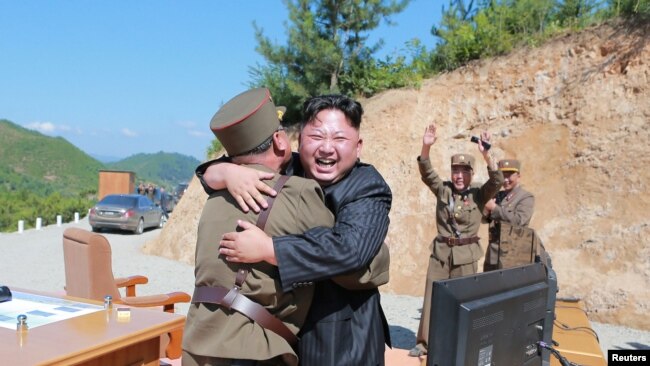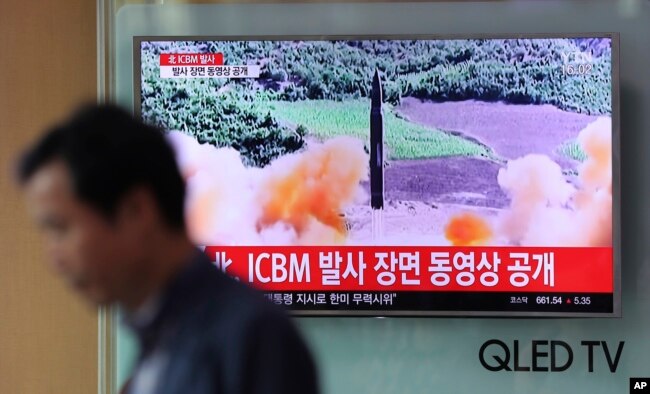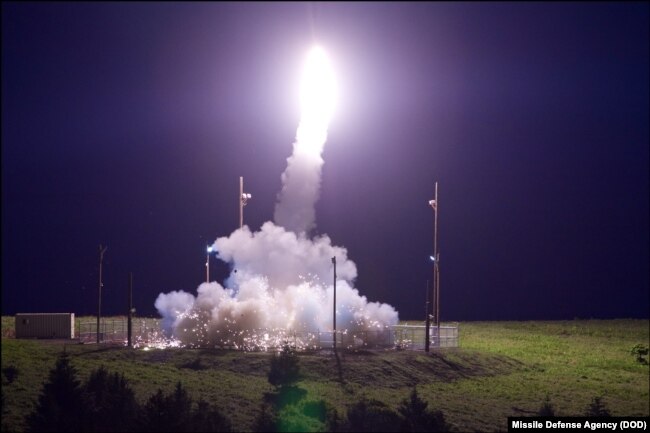
PENTAGON/WHITE HOUSE — China has condemned North Korea’s latest launch of an intercontinental ballistic missile, joining criticism by the United States and South Korea.
China’s foreign ministry said in a statement Saturday that the launch “defied” U.N. Security Council resolutions and “the common wish of the international community.”
US, South Korea missiles
U.S. and South Korean forces fired missiles into South Korean territorial waters in direct response to North Korea’s intercontinental ballistic missile launch Friday.
A statement from the Eighth United States Army said the joint, live-fire exercise used the Army Tactical Missile System (ATACMS) and the Republic of Korea Hyunmoo Missile II. The weapons can be quickly deployed and provide deep-strike precision capability under all weather conditions, according to the military.
A defense official told VOA the exercise began around 5:30 pm EDT.
A White House statement released shortly afterward called the North’s missile test a “reckless and dangerous action” which will further isolate the country.
The statement added that “the United States will take all necessary steps to ensure the security of the American homeland and protect our allies in the region.”
U.S. Secretary of State Rex Tillerson said North Korea’s latest launch was “in blatant violation of multiple United Nations Security Council resolutions.” The top U.S. diplomat added, “As the principal economic enablers of North Korea’s nuclear weapon and ballistic missile development program, China and Russia bear unique and special responsibility for this growing threat to regional and global stability.”
Two ICBM’s tested in July
North Korea’s intercontinental ballistic missile launch was the second such launch in just a few weeks. The latest launch flew higher and longer than the first ICBM Pyongyang launched July 4.
Pentagon spokesman Navy Captain Jeff Davis said North Korea launched the missile from Mupyong-ni arms plant in the country’s north.
Defense officials in Washington and Seoul, as well as private analysts, said the missile was in the air for 40 to 45 minutes, reaching a peak altitude of 3,000 kilometers and traveling some 1,000 kilometers laterally before splashing down about 160 kilometers west of Japan’s second-largest island of Hokkaido.
Japan said the missile fell into its exclusive economic zone.
Japanese Prime Minister Shinzo Abe termed Friday’s launch a “serious and real threat” to his country’s security.
Reassurances for South Korea
After Friday’s unusual late-night launch, Gen. Joseph Dunford, the chairman of the Joint Chiefs of Staff, and Admiral Harry Harris, the head of U.S. Pacific Command, called the Republic of Korea’s Joint Chiefs of Staff Chairman, General Lee Sun Jin to discuss military response options and reaffirm their “ironclad commitment” to the U.S.-Republic of Korea alliance, according to the U.S. Chairman’s office.
South Korean President Moon Jae-in said the launch by the North “clearly violates U.N. Security Council Resolution and it is a grave threat to international peace and security.”
Moon added that “once again we urge North Korea to awaken from a vain illusion such as developing a nuclear program and missiles and instead choose a new path for a dialogue.”
How to respond
While the type of missile tested is yet unconfirmed, the preliminary data is “fully consistent with a Hwasong-14 tested with a larger second stage that is powered by a high-thrust engine,” according to Michael Elleman, senior fellow for missile defense at the International Institute for Strategic Studies.
“If flown on a flatter trajectory, this missile could reach as far as 9,000 to 10,000 km,” (easily putting Seattle or San Francisco on the U.S. West Coast into range), according to Elleman, whose comments were published on the 38 North website of the US-Korea Institute at Johns Hopkins School of Advanced International Studies.
“The most worrying aspect is that the U.S. administration will not take this launch seriously due to preoccupation and in-fighting, giving North Korea more time to develop its program and more cause for US allies South Korea and Japan to lose confidence that the U.S. will come to their aid,” Melissa Hanham, a senior research associate with the James Martin Center of Nonproliferation Studies of the Middlebury Institute of International Studies at Monterey, told VOA.
“With no sign the Kim regime is prepared to back down, we must pursue a comprehensive approach that includes rigorous enforcement of sanctions, strengthening regional alliances, and expanded deployment of missile defense systems to confront this serious threat,” said a statement from Senator Bob Corker who chairs the Foreign Relations Committee. “Additional measures to enhance our efforts against North Korea are currently being considered.”
The French foreign ministry, in a statement, called for fellow members of the United Nations Security Council, in response to the launch, to swiftly impose “strong and additional sanctions” against North Korea. | via voanews
State Department Correspondent Nike Ching and Northeast Asia Bureau Chief Brian Padden in Seoul contributed to this report.



